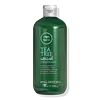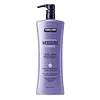What's inside
What's inside
 Key Ingredients
Key Ingredients

 Benefits
Benefits

 Concerns
Concerns

 Ingredients Side-by-side
Ingredients Side-by-side

Water
Skin ConditioningCetearyl Alcohol
EmollientIsohexadecane
EmollientIsododecane
EmollientBehentrimonium Methosulfate
Melaleuca Alternifolia Leaf Oil
AntioxidantHedychium Coronarium Root Extract
MaskingAscophyllum Nodosum Extract
Skin ConditioningAloe Barbadensis Leaf Extract
EmollientRosmarinus Officinalis Leaf Extract
AntimicrobialAnthemis Nobilis Flower Extract
MaskingSimmondsia Chinensis Leaf Extract
HumectantPPG-5-Ceteth-20
EmulsifyingCitric Acid
BufferingTetrasodium EDTA
Magnesium Nitrate
Bisamino PEG/PPG-41/3 Aminoethyl Pg-Propyl Dimethicone
PEG-12 Dimethicone
Skin ConditioningSodium Glycolate
BufferingMethylisothiazolinone
PreservativeMethylchloroisothiazolinone
PreservativeMagnesium Chloride
Sodium Hydroxide
BufferingParfum
MaskingLimonene
PerfumingCI 42090
Cosmetic ColorantCI 19140
Cosmetic ColorantWater, Cetearyl Alcohol, Isohexadecane, Isododecane, Behentrimonium Methosulfate, Melaleuca Alternifolia Leaf Oil, Hedychium Coronarium Root Extract, Ascophyllum Nodosum Extract, Aloe Barbadensis Leaf Extract, Rosmarinus Officinalis Leaf Extract, Anthemis Nobilis Flower Extract, Simmondsia Chinensis Leaf Extract, PPG-5-Ceteth-20, Citric Acid, Tetrasodium EDTA, Magnesium Nitrate, Bisamino PEG/PPG-41/3 Aminoethyl Pg-Propyl Dimethicone, PEG-12 Dimethicone, Sodium Glycolate, Methylisothiazolinone, Methylchloroisothiazolinone, Magnesium Chloride, Sodium Hydroxide, Parfum, Limonene, CI 42090, CI 19140
Water
Skin ConditioningSodium Cocoyl Isethionate
CleansingCocamidopropyl Hydroxysultaine
CleansingPotassium Cocoyl Glycinate
Disodium Cocoyl Glutamate
CleansingSodium Lauroyl Methyl Isethionate
CleansingSodium Lauroyl Sarcosinate
CleansingDecyl Glucoside
CleansingPotassium Cocoate
EmulsifyingGlycereth-26
HumectantGlycol Distearate
EmollientCocamidopropylamine Oxide
CleansingPhenoxyethanol
PreservativeParfum
MaskingSodium Cocoyl Glutamate
CleansingPEG-120 Methyl Glucose Dioleate
EmulsifyingMethyl Gluceth-20
HumectantQuaternium-91
Amodimethicone
Acrylates Copolymer
Citric Acid
BufferingDicaprylyl Ether
EmollientPolyquaternium-10
Guar Hydroxypropyltrimonium Chloride
Skin ConditioningChlorphenesin
AntimicrobialTrisodium Ethylenediamine Disuccinate
PPG-3 Benzyl Ether Myristate
EmollientGlyceryl Oleate
EmollientC11-15 Pareth-7
EmulsifyingPolyquaternium-39
Laureth-9
EmulsifyingPhospholipids
Skin ConditioningGlycerin
HumectantHydrolyzed Vegetable Protein Pg-Propyl Silanetriol
Skin ConditioningPolyquaternium-55
Sodium Benzoate
MaskingPanthenol
Skin ConditioningTrideceth-12
EmulsifyingGlycine Soja Oil
EmollientAcetic Acid
BufferingTetrasodium EDTA
Benzoic Acid
MaskingSodium Hydroxide
BufferingDisodium EDTA
Potassium Sorbate
PreservativeHydrolyzed Pea Protein Pg-Propyl Silanetriol
Skin ConditioningCaprylyl Glycol
EmollientTocopheryl Acetate
AntioxidantHelianthus Annuus Seed Oil
EmollientAlcohol
AntimicrobialTocopherol
AntioxidantArgania Spinosa Kernel Oil
EmollientAscorbic Acid
AntioxidantPersea Gratissima Oil
Skin ConditioningCopaifera Officinalis Resin
MaskingPassiflora Edulis Seed Oil
EmollientIsomalt
HumectantEuterpe Oleracea Fruit Oil
Skin ConditioningAloe Barbadensis Leaf Extract
EmollientCucumis Sativus Fruit Extract
EmollientLycium Barbarum Fruit Extract
AstringentPunica Granatum Extract
AstringentMalus Domestica Fruit Cell Culture Extract
Skin ConditioningQuaternium-95
UV AbsorberPropanediol
SolventCamellia Sinensis Leaf Extract
AntimicrobialPersea Gratissima Fruit Extract
EmollientXanthan Gum
EmulsifyingLecithin
EmollientVitis Vinifera Fruit Cell Extract
Skin ConditioningVitis Vinifera Seed Extract
AntimicrobialPentaerythrityl Tetra-Di-T-Butyl Hydroxyhydrocinnamate
AntioxidantWater, Sodium Cocoyl Isethionate, Cocamidopropyl Hydroxysultaine, Potassium Cocoyl Glycinate, Disodium Cocoyl Glutamate, Sodium Lauroyl Methyl Isethionate, Sodium Lauroyl Sarcosinate, Decyl Glucoside, Potassium Cocoate, Glycereth-26, Glycol Distearate, Cocamidopropylamine Oxide, Phenoxyethanol, Parfum, Sodium Cocoyl Glutamate, PEG-120 Methyl Glucose Dioleate, Methyl Gluceth-20, Quaternium-91, Amodimethicone, Acrylates Copolymer, Citric Acid, Dicaprylyl Ether, Polyquaternium-10, Guar Hydroxypropyltrimonium Chloride, Chlorphenesin, Trisodium Ethylenediamine Disuccinate, PPG-3 Benzyl Ether Myristate, Glyceryl Oleate, C11-15 Pareth-7, Polyquaternium-39, Laureth-9, Phospholipids, Glycerin, Hydrolyzed Vegetable Protein Pg-Propyl Silanetriol, Polyquaternium-55, Sodium Benzoate, Panthenol, Trideceth-12, Glycine Soja Oil, Acetic Acid, Tetrasodium EDTA, Benzoic Acid, Sodium Hydroxide, Disodium EDTA, Potassium Sorbate, Hydrolyzed Pea Protein Pg-Propyl Silanetriol, Caprylyl Glycol, Tocopheryl Acetate, Helianthus Annuus Seed Oil, Alcohol, Tocopherol, Argania Spinosa Kernel Oil, Ascorbic Acid, Persea Gratissima Oil, Copaifera Officinalis Resin, Passiflora Edulis Seed Oil, Isomalt, Euterpe Oleracea Fruit Oil, Aloe Barbadensis Leaf Extract, Cucumis Sativus Fruit Extract, Lycium Barbarum Fruit Extract, Punica Granatum Extract, Malus Domestica Fruit Cell Culture Extract, Quaternium-95, Propanediol, Camellia Sinensis Leaf Extract, Persea Gratissima Fruit Extract, Xanthan Gum, Lecithin, Vitis Vinifera Fruit Cell Extract, Vitis Vinifera Seed Extract, Pentaerythrityl Tetra-Di-T-Butyl Hydroxyhydrocinnamate
 Reviews
Reviews

Ingredients Explained
These ingredients are found in both products.
Ingredients higher up in an ingredient list are typically present in a larger amount.
Aloe Barbadensis Leaf Extract is an extract of the leaves of the aloe, Aloe barbadensis, Liliaceae.
Aloe is one of the most well-known natural soothing ingredients, and for good reason. It’s full of water and has a cooling, calming effect on the skin, especially when it’s sunburned, itchy, or irritated. Aloe also helps your skin stay hydrated and smooth by mimicking what healthy skin naturally produces. On top of that, it contains vitamins and nutrients that support skin recovery.
It doesn’t protect you from the sun, but it can help your skin bounce back after too much time in it.
Let’s get into the details:
Aloe contains antioxidant Vitamins A, C, and E, which help fight off free radicals (unstable molecules from things like pollution that can damage your skin).
It’s also rich in polysaccharides, which are natural sugars that help hydrate the skin by acting like the skin’s own moisturizing agents. These, along with other sugars like monosaccharides, help form a protective barrier that locks in moisture.
Aloe works as both a humectant and an emollient. That means it draws water into the skin (humectant) and helps trap it there (emollient), making it an effective natural moisturizer.
You’ll also find a mix of other skin-supporting ingredients in aloe, including folic acid, choline, calcium, amino acids, fatty acids, and even Vitamin B12.
Out of the 420+ species of aloe, Aloe barbadensis is the most widely used in skincare products thanks to its gentle yet effective properties.
There are over 420 species of aloe but Aloe Barbadensis is the most commonly used for topical products.
Learn more about Aloe Barbadensis Leaf ExtractCitric Acid is an alpha hydroxy acid (AHA) naturally found in citrus fruits like oranges, lemons, and limes.
Like other AHAs, citric acid can exfoliate skin by breaking down the bonds that hold dead skin cells together. This helps reveal smoother and brighter skin underneath.
However, this exfoliating effect only happens at high concentrations (20%) which can be hard to find in cosmetic products.
Due to this, citric acid is usually included in small amounts as a pH adjuster. This helps keep products slightly more acidic and compatible with skin's natural pH.
In skincare formulas, citric acid can:
While it can provide some skin benefits, research shows lactic acid and glycolic acid are generally more effective and less irritating exfoliants.
Most citric acid used in skincare today is made by fermenting sugars (usually from molasses). This synthetic version is identical to the natural citrus form but easier to stabilize and use in formulations.
Read more about some other popular AHA's here:
Learn more about Citric AcidParfum is a catch-all term for an ingredient or more that is used to give a scent to products.
Also called "fragrance", this ingredient can be a blend of hundreds of chemicals or plant oils. This means every product with "fragrance" or "parfum" in the ingredients list is a different mixture.
For instance, Habanolide is a proprietary trade name for a specific aroma chemical. When used as a fragrance ingredient in cosmetics, most aroma chemicals fall under the broad labeling category of “FRAGRANCE” or “PARFUM” according to EU and US regulations.
The term 'parfum' or 'fragrance' is not regulated in many countries. In many cases, it is up to the brand to define this term.
For instance, many brands choose to label themselves as "fragrance-free" because they are not using synthetic fragrances. However, their products may still contain ingredients such as essential oils that are considered a fragrance by INCI standards.
One example is Calendula flower extract. Calendula is an essential oil that still imparts a scent or 'fragrance'.
Depending on the blend, the ingredients in the mixture can cause allergies and sensitivities on the skin. Some ingredients that are known EU allergens include linalool and citronellol.
Parfum can also be used to mask or cover an unpleasant scent.
The bottom line is: not all fragrances/parfum/ingredients are created equally. If you are worried about fragrances, we recommend taking a closer look at an ingredient. And of course, we always recommend speaking with a professional.
Learn more about ParfumSodium Hydroxide is also known as lye or caustic soda. It is used to adjust the pH of products; many ingredients require a specific pH to be effective.
In small amounts, sodium hydroxide is considered safe to use. However, large amounts may cause chemical burns due to its high alkaline.
Your skin has a natural pH and acid mantle. This acid mantle helps prevent harmful bacteria from breaking through. The acid mantle also helps keep your skin hydrated.
"Alkaline" refers to a high pH level. A low pH level would be considered acidic.
Learn more about Sodium HydroxideTetrasodium EDTA is the salt formed from neutralizing ethylenediamine tetraacetic acid with sodium hydroxide. It is a chelating agent and used to prevent metal ions from binding to other ingredients. This helps keep the product and ingredients stable.
Tetrasodium EDTA comes as a white solid and is soluble in water.
Water. It's the most common cosmetic ingredient of all. You'll usually see it at the top of ingredient lists, meaning that it makes up the largest part of the product.
So why is it so popular? Water most often acts as a solvent - this means that it helps dissolve other ingredients into the formulation.
You'll also recognize water as that liquid we all need to stay alive. If you see this, drink a glass of water. Stay hydrated!
Learn more about Water